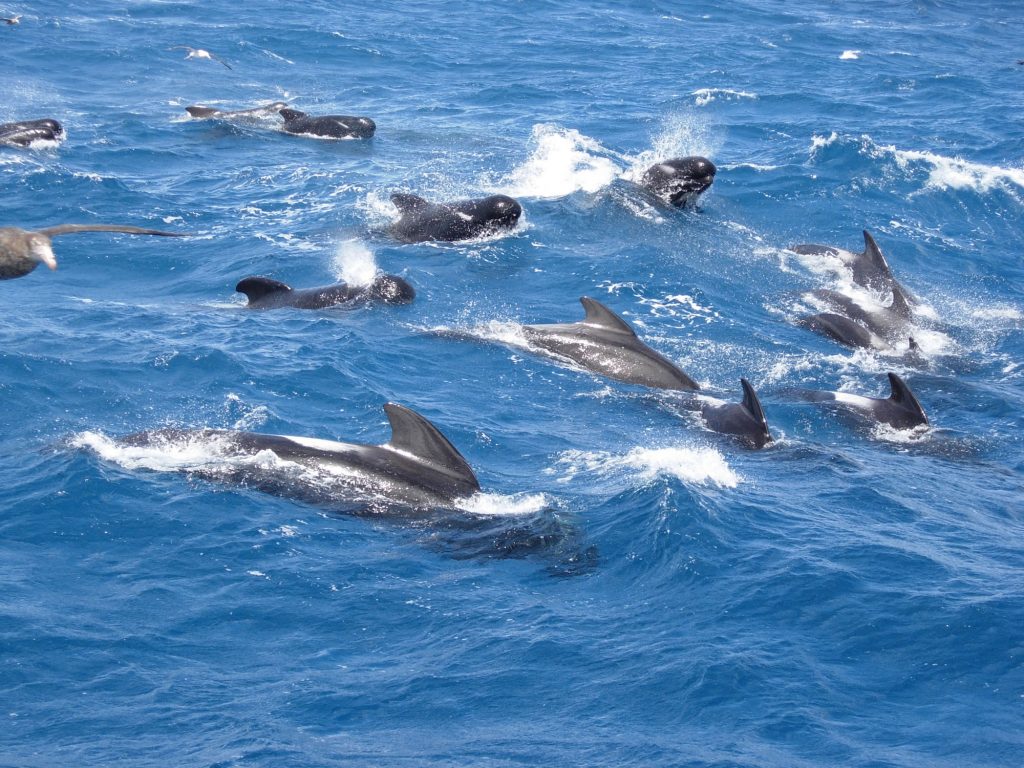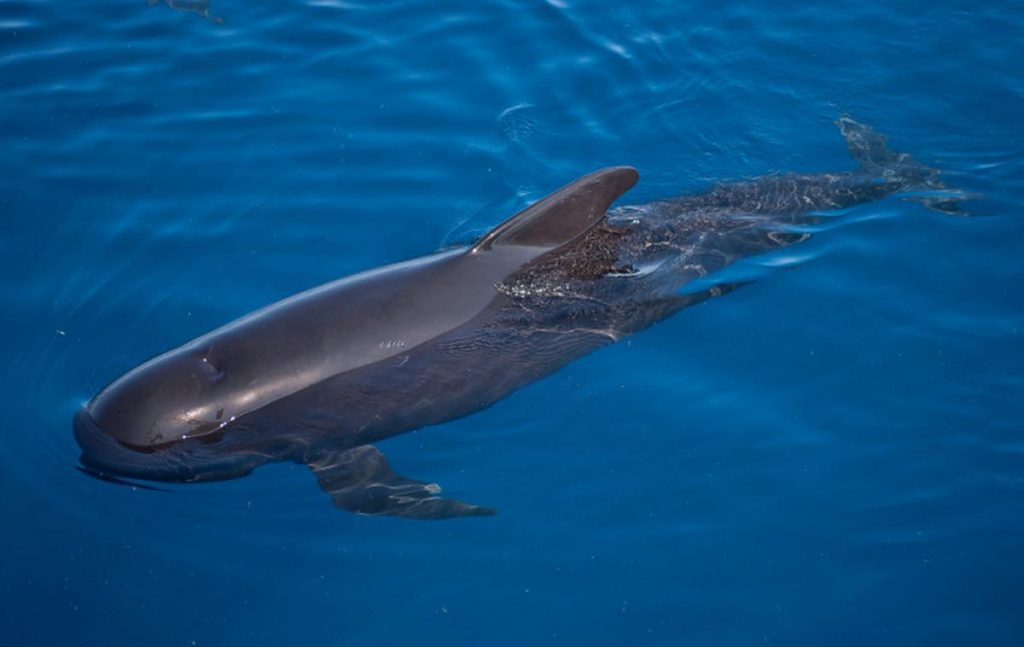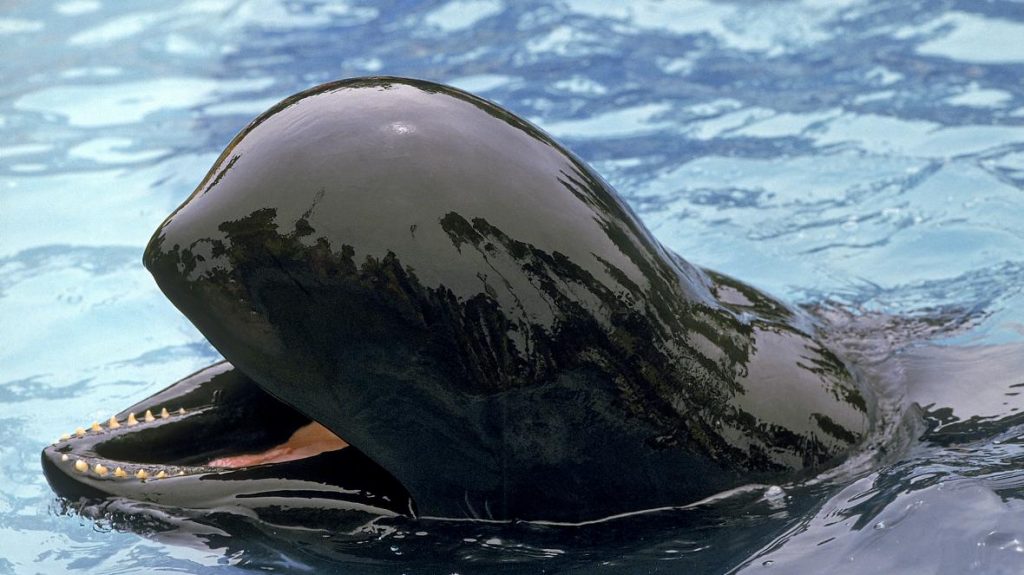This is the latest post in a series which will look at recent advancements, discoveries and trends in the study of whales and dolphins. We here at Sea Watch believe strongly in the free sharing and dissemination of scientific literature and want to give you, our loyal members, the breakdown of all that’s going on in the field.

Long-finned pilot whales are among the most secretive and elusive cetaceans in our oceans (Evans & Waggitt 2020). A fact made even more impressive when considering they are the second largest member of the dolphin family, growing up to 8.5m, only killer whales (or orca) being larger (Boran et al., 2008). Found across the Northern Atlantic, long-finned pilot whales are occasionally seen in UK waters, with Sea Watch’s National Sightings Database showing 11 sighting events across the UK from Cornwall to Shetland, in the last year alone. This included 30 individuals at once, sighted from a boat in Devon. However, they are usually found in groups of 10 – 14 individuals, these wandering giants are matrilineal; meaning their social groups are female led, with males leaving to find mates (Evans & Waggitt 2020).
Long-finned pilot whales are also found in the Southern hemisphere, and despite the complete lack of overlap in territory, the two populations are considered to be of the same species. Such a globally fractured population is linked to the warming of the worlds’ oceans at the end of the last ice age, around 10,000 years ago (Kraft et al., 2020).
These matrilineal groups often fuse during travelling or feeding events creating groups of over 100 individuals (Vester, 2017). These large gatherings, or super-pods, have rarely been documented, but are known to be important (Evans & Waggitt 2020). The complexity of these group interactions is cited as the primary reason why pilot whales are capable of some of the most complex vocal communication in the animal kingdom (Vester, 2017). The most important use of these calls is to allow individual animals to identify themselves to the group and identify those around them (Scheer, 2013). In the underwater world, where sound travels much farther and clearer than light, this is a huge advantage during the super-pod meet-ups, or while hunting (Vester, 2017).

The sheer size of the long-finned pilot whales means they have few natural predators. However, orcas are known to hunt other cetacean species of similar size, creating a more than credible threat of predation to the pilot whales (Visser et al., 2010). This potential predation has led to the development of some interesting deterrent techniques by pilot whales over time.
By playing orca hunting noises through underwater speakers, scientists have proven that long-finned pilot whales are in fact, attracted to the sound of hunting orcas (Cure et al., 2012). Such an attraction appears counter intuitive, with other studied cetaceans such as grey (Cummings & Thompson 1971) and beluga (Fish & Vania 1971) whales taking the safer option, and swimming away from the sound of their predators.
Perhaps the boldness of the species has some benefit however. In the aforementioned study, the hunting noises played by scientists were that of orcas hunting herring specifically (Cure et al., 2012). While the classification of orca pods is very complex, they may generally be split into two primary feeding groups; those that eat fish, and those that eat marine mammals. While there is some overlap and plasticity in the diet of orca feeding groups, it is possible the pilot whales, which have extremely sensitive hearing at the frequencies which orca use to communicate, may be able to differentiate fish eating orca from those mammal eaters who pose a potential threat. While the long finned pilot whales of the Atlantic generally feed on crustaceans and mackerel (Evans 2020), it is possible that they approach the hunting Orca to feed on the scraps left behind (Cure et al., 2012).
Another study has shown the pilot whale’s behaviour to be bolder even than this, rather than merely feeding on the leftovers once the orca are done; they physically harass and harry the orcas away from their prey in a behaviour known in nature as mobbing (Cure et al., 2012, De Stephanis et al 2015). Just as we see crows mobbing larger birds of prey over the fields of Britain, so too have pilot whales been seen mobbing orcas in European waters (De Stephanis et al 2015). This show of strength and toughness may act to deter the orcas from hunting pilot whales.
This story, however, has taken a new twist in recent months as researchers have identified that pilot whales in fact have the ability to imitate the calls of hunting orcas (Courts et al., 2020). While these mimicking pilot whales were found in Australian waters, their calls are markedly similar to their genetically identical cousins in the North Atlantic (Courts et al., 2020). By mimicking the calls of the orcas, they mark themselves as a threat rather than a food source to the orca, who will generally steer clear of unknown orca to avoid conflict (Courts et al., 2020).

The vocal range of pilot whales has long been studied, and this isn’t the first time pilot whales have been found to copy other underwater sounds, just like a parrot. Other studies have found they are capable of mimicking several types of military sonar (DeRuiter et al., 2012; Alves et al., 2014). Who knows what scientists will discover pilot whales copying next; just don’t expect to see one sitting on a pirate’s shoulder anytime soon!
Bibliography
Fish, J.F. and Vania, J.S., 1971. Killer whale, orcinus-orca, sounds repel white whales, delphinapterus-leucas. Fishery Bulletin of the National Oceanic and Atmospheric Administration, 69(3), p.531.
























